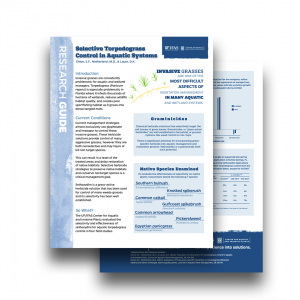Torpedograss (Panicum repens) is one of the most serious weeds in Florida, with management costs reaching approximately $2 million a year in flood control systems. By 1992, torpedograss had been found in over 70% of Florida’s public waters. This problematic plant is most difficult to control when partially submerged in water, forming monocultures where it quickly displaces desired native plants. In this study, UF/IFAS Center for Aquatic and Invasive Plants professor Dr. Stephen Enloe, alongside fellow researchers Dr. Netherland and Dr. Lauer, investigated the selectivity of the graminicide: sethoxydim in four field studies conducted across three sites in South Florida.
So What?
Selective herbicide solutions that preserve native habitats and conserve non-target plants are a critical aquatic plant management goal. Sethoxydim is a grass-active herbicide solution that has the potential to benefit aquatic plant management treatments and habitat restoration projects. Results indicate that invasive grass management without harming native plants is possible.
To read more about the experiment details, check out our research guides.
This research guide highlights:
- Current management strategies for torpedograss typically rely on glyphosate and imazapyr. These herbicide solutions are both nonselective and may injure non-target plants such as desirable native vegetation.
- UF/IFAS CAIP researchers not only examined the effectiveness of sethoxydim on torpedograss control but also explored its selectivity across native plants including Common arrowhead (Sagittaria latifolia), Common cattail (Typha sp.), Egyptian panicgrass (Paspalidium geminatum), Gulfcoast spikebrush (Eleocharis cellulosa), Knotted spikerush (Eleocharis interstincta), Pikerelweed (Pontederia cordata), and Southern bulrush (Schoenoplectus californicus).
- Results demonstrated that sethoxydim can target and help control torpedograss. Also, a high level of selectivity exists for sethoxydim among most native plants.
What is a Research Guide?
The UF/IFAS Center for Aquatic and Invasive Plants (CAIP) is a nationally and internationally recognized multidisciplinary research, teaching, and extension unit known for having the most relevant information on invasive plant management. This one-of-a-kind Center focuses on developing and disseminating strategies for addressing the impact of invasive plants.
In an effort to share their findings, CAIP researchers and the communications team collaborate to translate scientific journal articles into simple, easy-to-understand research guides. These one-page research guides are simplified summaries about research projects happening at the Center. They are created to assist plant industry professionals and the public understand new scientific information quickly and easily.
Follow UF/IFAS CAIP on social media at @ufifascaip. Read more blogs like this one on the UF/IFAS CAIP blog.
UF/IFAS Center for Aquatic and Invasive Plants. Turning Science Into Solutions.
Did you find this blog helpful? Click the heart below to let us know!
 2
2

